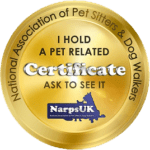Tips when doing Recall training
Did you know we have our very own field of freedom, this is great for recall training?. You can book this at www.rosecottagedoggydaycare.co.uk
Use a specific recall cue
Think how many times a day you say your dog’s name? Think how many times you say it and are not asking them to come to you, you’re just having general chit chat or perhaps even asking them to pay attention to what comes next from you.
It’s for this reason we need a clear and consistent recall cue. Whether that’s a tag-on word such as “come” or “here” or a slight change to your dog’s usual name.
Keep that cue consistent, rather than evolving it into lots of variations or different sounds. It’s not what you say, nor how you say it, it’s all in how you teach it!
If your dog’s recall cue doesn’t work, it’s because they don’t fully understand what it means and you need to revisit training.
Don’t repeat the cue
Following on from the point above, if your dog has not responded to the cue, try to avoid rapid firing it at them! All this will do is reduce cue saliency (the association/relationship between the word and the consequences). If your dog doesn’t respond you have two options; pause and try again or calmly and gently physically retrieve your dog.
Use the ‘wow’ factor to reinforce your dog
A small biscuit each time your dog returns to you may not motivate a recall away from something highly enjoyable, like playing with another dog or chasing a rabbit.
Surprise your dog with different treats, such as half a sausage or a crunchy piece of dried fish. We offer a £5 bag of natural treats including the very popular fish cubes. You can place an order for these when booking our Filed of Freedom or go to our online shop www.doglanddeals.com
If your dog loves toys, use them as reinforcers!
I personally do not throw toys or play tug ‘for free’. I tie all play and training in together as one game. There’s no rule that says they should be separate.
Be mindful of not throwing toys too often for your dog, so to protect their joints.
Be aware of distractions
In springtime, wildlife activity increases and can increase predatory behaviour in your dog. You may have to use a longline or walk somewhere else until your recall is reliable enough in prey dense areas.
The same goes for dogs and people. If your dog is highly social, be mindful to not walk them in such a high distraction environment every walk that your recall never gets a chance to succeed and develop more reliably
Use a longline
It’s important to prevent your dog running off while they are learning their recall. A longline is a great tool that allows your dog some freedom without being totally loose. They can drag the lead when playing with another dog, or you can take the lead off in areas where there are no distractions or your dog’s recall is more reliable.
Always attached a longline to a harness to prevent your dog’s neck from injuries.
The importance of ‘dog time’
Too much recall could come across as nagging. Be mindful to let your dog be when they are calm and not too distracted. It’s important to let them sniff as this is partially how they learn about the world, and can also be mentally tiring and contribute to a sleepy dog on you return home.
Good timing!
In the early stages of training, it helps to know when your dog is simply too distracted and will not hear you. If they are mid-sniff, about to cock their leg or looking at an approaching dog- recalling them may lead to failure from your recall cue.
Getting your timing right increases the success rate and increases cue saliency, which means your dog will more likely respond in higher distraction scenarios.
HAVE FUN!!
Recall training should be (mostly!) fun for both you and your dog. Try and enjoy the process and your dog will be more likely to enjoy coming back to you.











